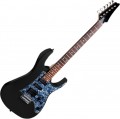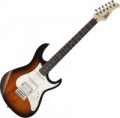Tone controls
The number of tone controls provided in the design of an electric guitar.
One tone control is responsible for the sound of the electric guitar as a whole; but if there are several such pens, they can have different formats of work. So, each knob can be responsible either for its own pickup, or for a separate frequency band. In the second case, a set of knobs plays the role of an equalizer that allows you to adjust the sound by changing the volume of low and high (sometimes even separately middle) frequencies.
Anyway, the presence of several tone controls expands the possibilities for changing the coloring of the sound by means of the guitar itself, without the use of additional equipment.
Material
The material from which the body of an electric guitar is made. For models with cutouts (semi-acoustic, see "Type"), in this case, only the material of the back deck and sides can be taken into account, and data on the top deck is given separately (for more details, see "Deck Cover Material").
Now on the market there are cases of such trees:
red,
maple,
agatis,
ash,
alder.
It makes no sense to dwell on each of the materials found in modern electric guitars. Their variety is very large, however, unlike acoustic guitars, the body in this case does not play such a significant role in shaping the sound, and its material has a relatively small effect on the acoustic properties of the instrument (although the exact degree of such influence is a moot point). If you wish, you can find detailed data on a particular material in special sources, but in fact it makes sense to look primarily at the appearance of the instrument and its price category.
Neck profile
Profile of a fretboard mounted on an electric guitar.
The profile of the neck is called its shape in section, more precisely, the shape of the back of the neck. This parameter practically does not affect the sound of the guitar, but it directly affects the convenience of playing. Ideally, the neck should “fill” the hand, but not be too large — otherwise it will not be possible to clasp it to the right extent.
Profiles are denoted by the letters C, D, V and U — depending on which letter the neck resembles in the section. Profile D is the flattest, C is slightly more convex, with almost uniform curvature along the entire length, U is more voluminous, with a wider profile in the area of the lining, and the V profile in its classic form has the form of an angle with a rounded top. There are also modifications of these options — for example, "thin", which provides for a reduced profile thickness, or "modern", with slightly improved (theoretically) ergonomics.
The most popular profile types are
C,
U and their "modern" (modern) modifications. The C profile is almost semi-circular, the U profile is more voluminous, at the fingerboard its edges are almost parallel and only closer to the back of the neck are sharply rounded. The terms
modern C and
modern U refer to various improved versions of these profiles, their f
...orm may be different.
In fact, the choice of neck profile depends solely on the guitarist's personal preferences, the characteristics of his hands and his preferred playing technique. Thus, there is no "perfect" profile shape — in each case, the optimal choice will be different. The perfect option is to try several types of profile "live", decide which one will be more convenient, and choose an instrument with a neck of the same or similar profile shape.Fretboard radius
The radius of curvature of a fretboard mounted on the fretboard of an electric guitar.
The fingerboard is located directly under the strings, it is to it that the musician presses the strings when playing. If you look at the neck in cross section, its upper part with the overlay will have the shape of an arc; the radius of this arc is implied in this case. The smaller the radius, the more convex this arc will be, and vice versa, a large radius will correspond to an almost flat surface.
In general, it is believed that a smaller fingerboard radius is better for playing chords, and a more even, flat surface makes it easier to play technical passages with an abundance of special techniques such as bands. The average and, one might say, classic diameter value is 12", this is the most popular option among modern electric guitars. The smallest figure is just over 7", it is found in some guitars with Stratocaster bodies (both original Fender instruments and copies ). And the most flat pads have a diameter of 20" or more.
Note that there are often instruments with a variable fretboard radius — smaller at the headstock (where chords are played more often) and larger near the body (where solos are played by notes). In such cases, the radius at the nut is indicated.
Strap
Shoulder strap included with electric guitar.
The strap not only allows the musician to play while standing, but can also come in handy in a sitting position. This is due to the fact that electric guitars (unlike acoustic ones) have a relatively small body thickness, and often also a specific shape; as a result, it can be difficult, if not impossible, to keep such an instrument on your knee without additional support. And even for semi-acoustic instruments (see "Type"), where this moment is not so pronounced, an additional "suspension" on the shoulder may be useful. Thus, an electric guitar strap is highly desirable anyway, and its presence in the kit can be very convenient — you don’t have to look for this accessory separately. On the other hand, almost all tools use the standard strap attachment, and the included strap may not be the correct length or design. Therefore, this configuration option is extremely rare, mainly among low-cost models — it is assumed that sophisticated guitarists prefer to choose a strap on their own, according to their own preferences.
Picks
A set of
picks is included with the guitar.
A pick is a small plate used when picking sound from strings. Using such a plate provides a more pronounced, accented sound than playing with fingertips; in addition, it is easier to use a plectrum to "metre" the effect on the string in terms of strength and sharpness. Thus, this way of playing is used by most guitar players, including world-class stars.
If picks are included in the package, then there are usually several of them — of different rigidity; thus, the guitarist can choose the most suitable option, depending on his own preferences and the characteristics of the technique. However, such equipment is rare and is typical mainly for low-cost instruments designed for beginners (of the “my first electric guitar” format). This is due to the fact that more or less experienced musicians often prefer not to rely on the choice of the manufacturer, but to purchase picks separately, in accordance with their own criteria.

